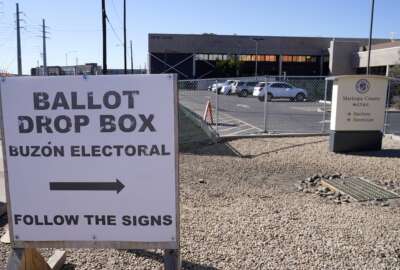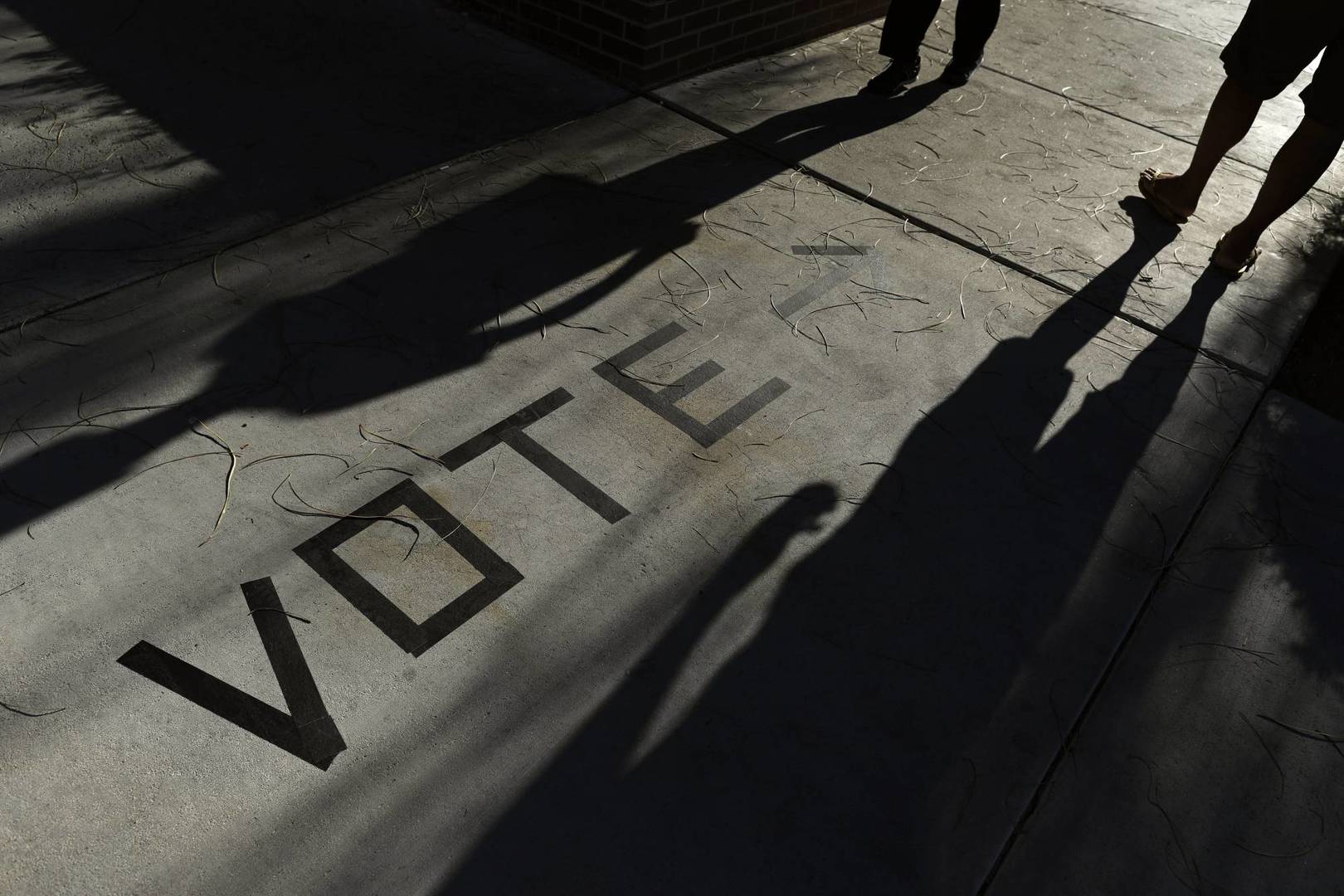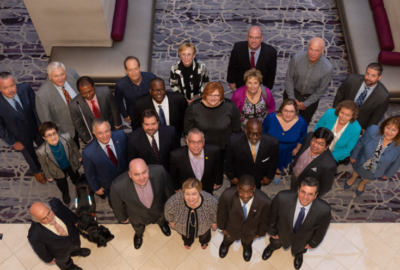Hubbard Radio Washington DC, LLC. All rights reserved. This website is not intended for users located within the European Economic Area.
Federal guidance for how to standardize elections
A new report from the U.S. Election Assistance Commission (EAC) tested the durability of a new kind of way for people to vote. Electronic poll books, or e-poll ...
A new report from the U.S. Election Assistance Commission (EAC) tested the durability of a new kind of way for people to vote. Electronic poll books, or e-poll books, look to replace paper records and allow access to digital voter registration records. As you can imagine though, with convenience comes the opportunity for that information to fall into the wrong hands. So have should e-poll books be secured? To dive into the topic, Federal Drive with Tom Temin Executive Producer Eric White talked with Christy McCormick Chairwoman of the EAC.
Interview Transcript:
Eric White Absolutely. So can you just sort of start out at the baseline here of explaining to us what e-poll books are and what are they designed to do in furthering American election technology.
Christy McCormick Sure. E-Poll books have been in use for, I would say, since about late 2008, 2009 time period. Started with about, you know, 12 or 13 states using these, maybe 15 years ago. Were up to 60% of the country using them at this point. They are electronic EPB or electronic poll book and they seek to either supplement or replace the old paper poll books that we had at the polling places. And voters may recall and people may recall going into a polling place and a poll worker flipping through a huge book looking for your name. These will replace those books. They do replace those books. And generally they will take, for example, an I.D. like your license and scan it or swipe it through the machine so that you get the correct ballot and that they check to make sure that you’re an eligible voter, to make sure that you’ve only been issued one ballot. There’s many uses for these books. They also provide some data afterwards. So we know how many people checked into a polling place, how many people voted. And we can use the voter history and documentation of the voters voting.
Eric White And yeah, that wait for while they’re flipping through. For some reason, I’m always nervous. I don’t know why. I’m always scared they’re not going to be able to find me. But it sounds like that this will kind of streamline things a little bit in the states that are using it and where is it being used today?
Christy McCormick So as I said, about 60% of the states, about 40 states are using them at this point statewide, and some states about half and have some states, some only some jurisdictions are using them. And some states allow the jurisdictions themselves to choose this kind of technology. And sometimes it’s done on the state level, but it’s varied across the country. Many states use it across the whole state does speed up lines. It has sped up the process significantly and it helps the poll workers, you know, make sure that they have accurate and up to date information for every voter that walks in the door.
Eric White So that information is the center of what you all we’re trying to find out is it is a secure way of holding people’s voting information. What were you all trying to look at in testing this technology out?
Christy McCormick So we’ve been hearing for many, many years that this is something that the election officials want us to do to have this technology tested. We’ve had a testing program for the actual voting systems themselves that was authorized to the Election Assistance Commission through the Help America Vote Act after the Bush v Gore race. But the election supporting technology, those things we don’t vote on that might be connected to the Internet, for example, or to a cloud. Those things have not been formally tested on a federal level. Many states have their own testing programs, but we have never had federal standards or federal testing of these this type of equipment. This is something that election officials have been interested in. We’ve heard from congressmen, senators that they’re interested in this happening. So a couple of years ago, we formulated this program. We finally got funding to do this program last year from Congress. And so we initiated it and we invited a number of commercial manufacturers of these electronic poll books and state and local state jurisdictions and local jurisdictions who may have what we consider home grown electronic poll back systems, brought those in, got laboratories, accredited laboratories to do the testing. We had to draft some requirements. We based these on other requirements that states have that we have in our own voting system. Testing program brought those machines and we had five commercial manufacturers and two state and local jurisdictions. So we had seven e-poll books that we were testing. They are the majority of what the systems that are used in the country, especially the commercial. And we had them go through testing and laboratories to make sure that they were secure, that they are accessible and usable. So for things like, you know, screen height, you know, multi-factor authentication, the security functions on them, what do they have in place to mitigate any sort of hacking that might be attempted? So a huge number of factors go into it, requirements of testing. And fortunately, all of the books that we tested passed those draft requirements. I think the one area that we would like to see some improvement in is the way that the manufacturers of home grown systems document the features that are available, the technical specifications so that things that aren’t visibly present to the eye we can make sure are being tested and are secure and usable and accessible as necessary.
Eric White We’re speaking to Christy McCormick. She’s the chairwoman of the Election Assistance Commission, and she’s also the designated federal officer for the Technical Guidelines Development Committee. Can you tell me a little bit about that committee and what it does? Is it more in line with what this test was looking at, in looking at the technology surrounding an election rather than directly counting votes?
Christy McCormick Well, the Technical Guidelines Development Committee was a FACA, a federal assistance committee set up by the Help America Vote Act. Congress set that up to assist us in setting the standards and the requirements for voting systems themselves. They haven’t been involved directly, although we have asked them for advice on this particular program, and we will be having a meeting of that group coming up shortly in early December and we’ll do a presentation to them. But they that committee is technical experts who help us with drafting and making sure that we cover all the necessary requirements for testing voting systems.
Eric White Got it. Okay. And so how deep can you go into the technologies that surround an election? As you mentioned, you know, you may not think of somebody actually hacking a voting machine, but, you know, it could be something as simple as, you know, somebody getting into a laptop at a voting place or something like that. Is that the next step in this or is it just going to be continually monitoring this technology itself?
Christy McCormick No, we’re going to add some other technologies, but this is our first tech election supporting technology that we are testing. And we will set these requirements and then we will turn to something like a blank ballot delivery. We’re going to look at election night reporting. We’re going to look at voter registration systems. So we’re going to look at a number of different types of equipment and systems that support voting in the country. And it’s important that all of these are looked at for security. We’ve never had any evidence that the actual voting system has been hacked into a real time basis. We have had some whitehat hackers in a different environment do that. So far, nothing has ever been shown to us to have shown that the systems themselves have been hacked. But we have had a couple of reports. I think in 2016 we saw that a voter registration database was put on the dark web. So, you know, we are concerned about the security of our voters information and how it’s used. And so this will help us secure that data from outside hacking.
Eric White Yeah, with election security, you know, really in the forefront of so many different news stories, I’d be apt not to ask a person like yourself in this position, you know, what is your overall sense of the security of American election technology?
Christy McCormick I think it’s very secure. You know, there’s always a risk. We always have to stay ahead of bad guys who try to hack into this and nation state actors who are interested in doing this. One thing I would say is that most voters don’t realize how deep the layers of testing are. We do a lot of testing on our voting systems, not only on the federal level, but on the state level. Sometimes there’s two different certified testing and certification programs, but also at the local level before every election. Most jurisdictions, if not all, do something that’s called logic and accuracy testing, where they actually put ballots through the actual machines that are going to be used on voting day to test to make sure that they’re tallying those votes and that they’re secure. Voters are usually the public is usually invited to go visit and watch that process or even participate in it. But we do have very strict guidelines for the security of our machines, where they’re kept, how they’re kept, and, you know, how they should be handled, the chain of custody of the machines. So I would say that they’re very secure. I think there are some processes that may not be as secure as our voting voting machines themselves. But I have full confidence on our voting systems. We do sometimes see anomalies happen, sometimes screens slip. You know, there’s environmental factors that affect the way a machine works, but that’s not generally a security issue. That’s either human error or just environmental issues that we need to address. We do look at those kinds of things as well in the testing. We test the machines to very low temperatures and very high temperatures. We check to see whether, you know, there’s some sort of possibility of human error on how the machines are used and set up. But in general, I would say voters can be very confident in the security of our systems and they should go vote on election day. We just had an election day, but we’re coming up on 24. So make a plan to vote next year, both in your primaries if you have one, and the general election.
Copyright © 2024 Federal News Network. All rights reserved. This website is not intended for users located within the European Economic Area.
Eric White
Eric White is news anchor and Federal Drive producer at Federal News Network.
Follow @FEDERALNEWSCAST
Related Stories
Related Stories
-
How a small federal commission tries to spur innovation in elections For Your Benefit





